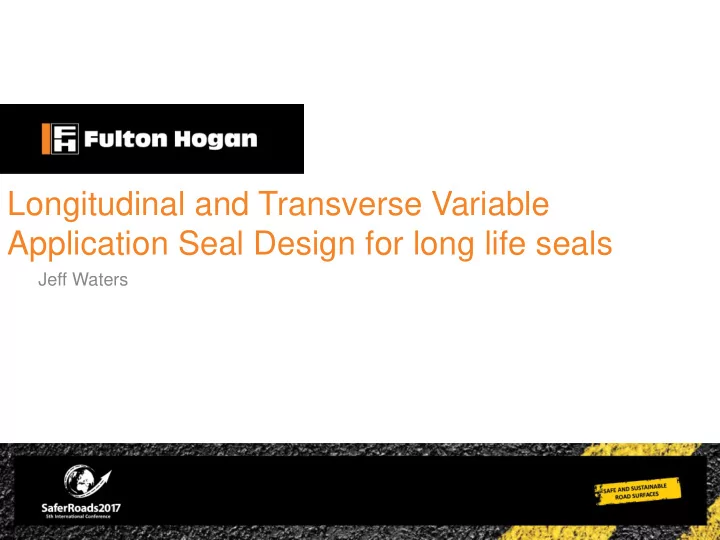

Longitudinal and Transverse Variable Application Seal Design for long life seals Jeff Waters
Introduction • Problems • Root Cause • Solution – TVAS • Trials – Increased Lives • Design – Back to Basics • Future Longitudinal and Transverse Variable Application Seal Design for long life seals – Jeff Waters
Problem • Reduced Funding • Less Renewals • Impractical Requirements • Rapidly Deteriorating Substrates • Variable surface condition • Increasing Risk • Shortening Seal Lives • Economically driven treatment selection • LCCA – Ignored
Root Cause – NZ Seal Design Practice • Main inputs to Seal Design Algorithm – Chip Size ALD – Traffic – Existing Texture • ALD okay – Modern chip shape more cubic – Different crushing methods
Traffic • Designs use 100% traffic everywhere – Uses AADT – Changes HCVs into cars (x10) • HCVs do all of the damage • Most HCVs run in wheelpaths • Very few HCVs run elsewhere
Texture Wheelpaths have least texture • Traffic embeds chip into substrate • Traffic reorients chip • Traffic pumps water into surface • Traffic suck binder to surface Flushing • Binder level up to chip height Repairs • Digouts - coarse texture • Asphalt – fine texture
Result of Current Seal Design Practice • Too Much Binder in the Wheelpaths • Not enough Binder Elsewhere • Compounding Errors – Less void fills and texturising – Early reseal on coarse polished seals – Early reseal on prematurely failed seals • Seals over coarse texture – Binder to fill voids – Increases B:S Ratio – Chip bridges existing chip
Solution – TVAS • TVAS – Transverse Variable Application Sealing • Simple just calculate the appropriate rate for each transverse location: – Wheelpaths – Shoulders – Between Wheelpaths – Centreline • Possible methodology for design? – Design for shoulders and deduct for wheelpaths – Design for wheelpaths and add for shoulders – Design for site and deduct from wheelpaths
TVAS Design • Design for each location across the road need: – Location – Texture – Traffic • Texture – simple – Sand Circles – Lasers • Location – Measure
Traffic Location • Issue Ignored • Our designs aren’t that bad – are they • All NZ design algorithms use total traffic • Total traffic doesn’t run in wheelpaths • How much traffic runs on the centreline? • What about the shoulders? • Does any traffic run between the wheelpaths?
Traffic Data Research suggests: • Most reduction of seal texture caused by HCVs • Straight sections of two laned highway with edge lines and narrow shoulders. – 60-80% of HCVs travel in identified wheelpaths – Wheelpath width ranges from 0.5 – 0.9m depending on lane width • On curved sections traffic distribution is too variable
Design for Wheelpaths • Current factors use 100% of traffic and too heavy • 70% of HCVs for Traffic Factor • Need a lower traffic factor • Trials have shown that 20% reduction from current design application rate works for wheelpaths • Factor based on 70% of HCVs and 20% lower than standard
Design for Other than Wheelpaths • Research Traffic Location data suggests: – 15% HCVs Between Wheelpaths – 7.5% HCVs on Shoulders – 7.5% HCVs on Centreline • Performance of trial seals suggests: – Shoulders, Centreline and Between Wheelpaths all lose chip with standard design – No flushing with up to 35% more binder on shoulders – Increase by 15% for improved results
Construction using Multispray™ • 7m Telescopic • Infinitely Variable width • Spray width 0.3m to 7m • Change up to 5 pre-set spray patterns on run • 70% to 170% variation for each 100mm increment
Plan View of Spray Bar Telescopic Motion Back View of Spray Bar
Variable Application Plan View of Spray Bar Low Flow Nozzle High Flow Nozzle High Flow Nozzle Low Flow Nozzle Back View of Spray Bar High Flow Spray Low Flow Spray Jets Jets 100% 100% 90% 100% 90% 90% 90% 80% 80% 80% High Flow Spray Low Flow Spray 70% Jets Jets Wheel Wheel Shoulder Path Path Spray Rate Profile
Result • Safer Road Surfaces – Consistent texture – Better friction – Less loose chip • Longer seal lives – Less flushing – Binder where needed – Chip retention
Acknowledgements • Fulton Hogan • NZTA • University of Canterbury
Recommend
More recommend